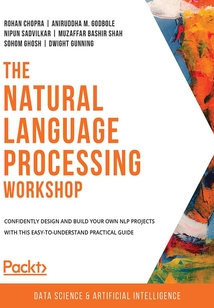舉報 

會員
The Natural Language Processing Workshop
最新章節(jié):
8. Sentiment Analysis
DoyouwanttolearnhowtocommunicatewithcomputersystemsusingNaturalLanguageProcessing(NLP)techniques,ormakeamachineunderstandhumansentiments?DoyouwanttobuildapplicationslikeSiri,Alexa,orchatbots,evenifyou’veneverdoneitbefore?WithTheNaturalLanguageProcessingWorkshop,youcanexpecttomakeconsistentprogressasabeginner,andgetuptospeedinaninteractiveway,withthehelpofhands-onactivitiesandfunexercises.ThebookstartswithanintroductiontoNLP.You’llstudydifferentapproachestoNLPtasks,andperformexercisesinPythontounderstandtheprocessofpreparingdatasetsforNLPmodels.Next,you’lluseadvancedNLPalgorithmsandvisualizationtechniquestocollectdatasetsfromopenwebsites,andtosummarizeandgeneraterandomtextfromadocument.Inthefinalchapters,you’lluseNLPtocreateachatbotthatdetectspositiveornegativesentimentintextdocumentssuchasmoviereviews.Bytheendofthisbook,you’llbeequippedwiththeessentialNLPtoolsandtechniquesyouneedtosolvecommonbusinessproblemsthatinvolveprocessingtext.
目錄(67章)
倒序
- 封面
- 版權(quán)信息
- Preface
- 1. Introduction to Natural Language Processing
- Introduction
- History of NLP
- Text Analytics and NLP
- Various Steps in NLP
- Word Sense Disambiguation
- Sentence Boundary Detection
- Kick Starting an NLP Project
- Summary
- 2. Feature Extraction Methods
- Introduction
- Types of Data
- Cleaning Text Data
- Feature Extraction from Texts
- Finding Text Similarity – Application of Feature Extraction
- Summary
- 3. Developing a Text Classifier
- Introduction
- Machine Learning
- Supervised Learning
- Developing a Text Classifier
- Building Pipelines for NLP Projects
- Saving and Loading Models
- Summary
- 4. Collecting Text Data with Web Scraping and APIs
- Introduction
- Collecting Data by Scraping Web Pages
- Dealing with Semi-Structured Data
- Summary
- 5. Topic Modeling
- Introduction
- Topic Discovery
- Topic-Modeling Algorithms
- Key Input Parameters for LSA Topic Modeling
- Hierarchical Dirichlet Process (HDP)
- Summary
- 6. Vector Representation
- Introduction
- What Is a Vector?
- Summary
- 7. Text Generation and Summarization
- Introduction
- Generating Text with Markov Chains
- Text Summarization
- Key Input Parameters for TextRank
- Recent Developments in Text Generation and Summarization
- Practical Challenges in Extractive Summarization
- Summary
- 8. Sentiment Analysis
- Introduction
- Tools Used for Sentiment Analysis
- The textblob library
- Understanding Data for Sentiment Analysis
- Training Sentiment Models
- Summary
- Appendix
- 1. Introduction to Natural Language Processing
- 2. Feature Extraction Methods
- 3. Developing a Text Classifier
- 4. Collecting Text Data with Web Scraping and APIs
- 5. Topic Modeling
- 6. Vector Representation
- 7. Text Generation and Summarization
- 8. Sentiment Analysis 更新時間:2021-06-11 18:39:41
推薦閱讀
- 數(shù)據(jù)庫基礎(chǔ)教程(SQL Server平臺)
- PyTorch深度學習實戰(zhàn):從新手小白到數(shù)據(jù)科學家
- R數(shù)據(jù)科學實戰(zhàn):工具詳解與案例分析(鮮讀版)
- 數(shù)據(jù)結(jié)構(gòu)與算法(C語言版)
- Spark核心技術(shù)與高級應(yīng)用
- 3D計算機視覺:原理、算法及應(yīng)用
- 數(shù)據(jù)革命:大數(shù)據(jù)價值實現(xiàn)方法、技術(shù)與案例
- 淘寶、天貓電商數(shù)據(jù)分析與挖掘?qū)崙?zhàn)(第2版)
- 智慧的云計算
- Hadoop集群與安全
- 實用數(shù)據(jù)結(jié)構(gòu)
- 數(shù)據(jù)庫原理與設(shè)計實驗教程(MySQL版)
- 數(shù)據(jù)分析思維:產(chǎn)品經(jīng)理的成長筆記
- Unity Game Development Blueprints
- 數(shù)據(jù)庫技術(shù)與應(yīng)用:SQL Server 2008
- 2D 計算機視覺:原理、算法及應(yīng)用
- Visual Studio 2010(C#)Web數(shù)據(jù)庫項目開發(fā)
- 圖數(shù)據(jù)庫原理、架構(gòu)與應(yīng)用
- 一本書讀懂移動大數(shù)據(jù)
- R語言與數(shù)據(jù)挖掘
- 實用數(shù)據(jù)分析
- 云計算和大數(shù)據(jù)服務(wù):技術(shù)架構(gòu)、運營管理與智能實踐
- Spark大數(shù)據(jù)處理:技術(shù)、應(yīng)用與性能優(yōu)化
- PostgreSQL服務(wù)器編程
- 數(shù)據(jù)庫系統(tǒng)及應(yīng)用(第2版)
- 涂抹Oracle:三思筆記之一步一步學Oracle
- Oracle J.D.Edwards技術(shù)與應(yīng)用:基礎(chǔ)篇
- 云數(shù)據(jù)管理實戰(zhàn)指南
- Learning SciPy for Numerical and Scientific Computing
- 計算機視覺特征檢測及應(yīng)用

